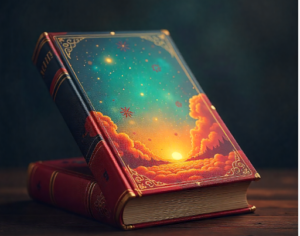Ultimate Guide to Book Illustrations | Enhance Your Story with Art

Books can transport us to fantastical worlds and introduce us to unforgettable characters. But have you ever stopped considering the role illustrations play in this captivating experience?
They’re more than just decorative elements, illustrations are silent storytellers working in tandem with the written word to create a richer, more immersive experience for the reader.
Whether a detailed map guides us through a fictional kingdom or a character’s expressive face conveys a hidden emotion, illustrations can breathe life into the narrative.
This guide delves into how illustrations can elevate a book, from enhancing comprehension to deepening emotional connection. By understanding the power of pictures, you can unlock the true potential of your book and leave a lasting impression on your readers.
The Power of Pictures: Unlocking Understanding and Engagement
Illustrations aren’t mere decoration; they’re a bridge to understanding complex concepts and a key to keeping readers engaged.
In this section, we’ll explore how illustrations function as powerful visual storytellers and how they break up text walls, creating a more dynamic reading experience.
A. Visual Storytelling: Making the Invisible Visible
The human brain is wired to process visuals faster than text. Illustrations leverage this strength to make the invisible visible.
In science books, for example, a detailed diagram of the human cell with labeled organelles can instantly clarify what a paragraph might struggle to convey.
Imagine grasping the intricate dance of electrons within an atom through text alone. An illustration depicting the orbiting electrons and their varying energy levels makes the concept readily comprehensible.
This isn’t limited to scientific explanations. Children’s literature thrives on the power of visual storytelling. Consider a picture book showcasing a butterfly’s life cycle.
Vibrant illustrations depicting a fuzzy caterpillar transforming into a stunning butterfly enhance the narrative and plant the seeds of scientific curiosity in young minds.
Examples abound across genres:
- Historical Fiction: Imagine a scene depicting a bustling marketplace in ancient Rome. The illustration can showcase the architecture, clothing styles, and daily life of the citizens, enriching the historical context for the reader.
- Fantasy: A detailed map of a fantastical kingdom with sprawling mountains, sparkling rivers, and intricate city layouts can spark readers’ imagination and invite them to inhabit this fictional world.
Illustrations aren’t passive bystanders; they actively participate in storytelling, making the abstract concrete, and complex clear.
B. Breaking Up Text Walls and Pacing the Narrative
Dense blocks of text can be intimidating, especially for younger readers. Illustrations act as visual breaks, allowing readers to rest their eyes and re-engage with the narrative.
A captivating illustration depicting the scorching sun beating down on the parched landscape and the weary travelers trudging onward can break up the monotony and keep the reader invested in the story’s progression.
Furthermore, illustrations play a crucial role in pacing the narrative. Imagine a thrilling chase scene. A series of dynamic illustrations showcasing the hero dodging obstacles and the villain closing in can create a sense of urgency and excitement, propelling the reader forward in the story.
Conversely, a peaceful scene depicting a character gazing at a starlit sky can create a sense of tranquility and introspection. Illustrations, therefore, act as visual cues, guiding the reader’s emotional journey through the story’s rhythm.
Deepening the Narrative: Where Illustrations Breathe Life into the Story
Illustrations go beyond mere comprehension; they act as silent collaborators, breathing life into characters and setting the story’s atmosphere.
Let’s delve into how illustrations enhance character development and establish the mood and ambiance of the narrative.
A. Unveiling the Soul: Character Development Through Visuals
A well-crafted illustration can reveal a character’s essence more profoundly than words alone. Clothing choices, hairstyles, and physical features combine to paint a vivid picture, allowing readers to form a mental image and connect with the characters on a deeper level.
Imagine a description of a wise old wizard – is it a wizened figure with a flowing beard and twinkling eyes or a stern individual with a bald head and piercing gaze? An illustration can solidify this image, etching the character’s appearance into the reader’s mind.
But illustrations go beyond the physical. Facial expressions and body language showcased in illustrations can speak volumes about a character’s emotions.
A character clenching their fists and gritting their teeth conveys determination or anger far more effectively than a simple sentence stating the emotion.
Likewise, a character with a gentle smile and warm eyes instantly evokes feelings of kindness and compassion. Illustrations allow readers to witness these emotions firsthand, forging a stronger connection with the characters’ inner world.
B. Setting the Stage: Illustrations and the Power of Ambiance
The setting of a story is often as important as the characters and plot. Illustrations have the remarkable ability to transport readers to different worlds, establishing the tone and ambiance of the narrative.
Imagine a scene set in a grand medieval castle. An illustration depicting towering stone walls, ornate tapestries, and flickering torches instantly sets the stage for a story of intrigue and adventure.
Conversely, a scene set in a lush rainforest can be brought to life with vibrant illustrations showcasing towering trees, exotic flora and fauna, and a misty canopy overhead, creating a sense of mystery and wonder.
Illustrations can even depict fantastical settings beyond the realm of reality. Imagine a story set in a magical underwater kingdom.
An illustration showcasing shimmering coral reefs, bioluminescent creatures, and majestic merfolk swimming amidst the ruins of an ancient civilization can transport readers to this fantastical world, allowing them to experience its beauty and wonder alongside the characters.
By establishing the mood and atmosphere, illustrations become an integral part of the world-building process, immersing readers in the story’s environment and enriching their emotional connection to the narrative.
Choosing the Right Illustrations: Finding the Perfect Visual Voice
Having explored the power of illustrations, we now turn to the art of selecting the right ones for your book.
Just as the genre of your book shapes the written narrative, the illustration style should complement and enhance the story’s tone.
A. A Symphony of Style: Matching Illustrations to Genre
The visual language of your illustrations should resonate with the genre of your book. Imagine a historical fiction novel detailing the life of a courageous knight.
Realistic illustrations depicting detailed armor, medieval weaponry, and imposing castles would be a perfect fit.
Conversely, a whimsical children’s book about a talking animal might benefit from more cartoonish illustrations with vibrant colors and exaggerated features.
Beyond genre, consider the illustration technique as well.
Watercolor illustrations often lend themselves to stories with a softer, more lyrical tone, while digital art can be used to create dramatic lighting effects and futuristic landscapes.
Here are some additional points to consider:
- Age of your target audience: Younger readers often respond better to simpler, more colorful illustrations, while older audiences might appreciate more detailed and nuanced artwork.
- The overall mood of the story: Dark and suspenseful stories might benefit from illustrations with muted tones and sharp contrasts, while lighthearted and humorous stories can be enhanced by bright colors and playful compositions.
B. The Art of Collaboration: Authors and Illustrators Working in Tandem
For self-published authors, finding the perfect illustrator requires clear communication and collaboration. Here are some key aspects to consider:
- Provide detailed descriptions: Character sketches, mood boards, and specific scene descriptions can help the illustrator visualize your vision.
- Open communication: Discuss your expectations, preferred styles, and any revisions needed throughout the process.
- Character Design: Collaborate on character design, ensuring physical details and expressions align with your vision.
- Scene Depiction: Work together to ensure illustrations accurately portray specific scenes and capture the desired atmosphere.
By fostering a strong collaborative spirit, you can ensure the illustrations seamlessly blend with your narrative, creating a truly cohesive reading experience.
C. The Power of Less: When to Use Minimalist Illustrations
While illustrations can be incredibly powerful tools, there are times when a minimalist approach might be more effective. Here’s when considering a simpler style might be the way to go:
- Focus on Text-Heavy Genres: For genres like literary fiction or historical non-fiction, where intricate details and internal monologues take center stage, extensive illustrations might overwhelm the reader and detract from the power of the written word.
- Leaving Room for Imagination: Sparse illustrations can spark the reader’s imagination, allowing them to visualize the story and characters based on their own interpretations. This can be particularly effective in genres like horror or mystery, where creating a sense of suspense and allowing the reader to fill in the blanks can heighten the reading experience.
- Emphasis on Emotional Impact: A single, powerful illustration can sometimes evoke a stronger emotional response than a multitude of detailed images. This can be a great way to highlight a pivotal moment in the story or leave a lasting impression on the reader.
Remember, the key is to find the right balance between illustration and text to serve your story best. Don’t be afraid to experiment and explore different styles to see what resonates with your audience.
Key Takeaways
Throughout this exploration, we’ve delved into the transformative power of illustrations in books. We’ve seen how illustrations act as visual storytellers, enhancing comprehension of complex concepts and breaking up text walls to keep readers engaged.
Furthermore, illustrations breathe life into characters, showcasing physical details and emotions that deepen readers’ connection to the narrative.
They also establish the mood and atmosphere of the story, transporting readers to different worlds and enriching their emotional experiences.
Illustrations can make a book more accessible to readers of all ages and learning styles. Additionally, well-crafted illustrations can grab attention on bookstore shelves and online platforms, boosting a book’s marketability.
In today’s visually driven world, illustrations are no longer mere embellishments; they are essential storytelling tools that can elevate a book and leave a lasting impression on readers.
So, the next time you pick up a book, take a moment to appreciate the silent symphony of words and pictures working in tandem.
Illustrations are not just decorations but portals to the imagination, enriching the narrative and inviting readers to participate in the story’s unfolding actively.
Ready to bring your book to life with stunning illustrations?
Hancock Publishers is an eBook writing company with a team of talented writers and passionate designers all ready to help you get your book written, illustrated and published.
Let us help you in creating illustrations that perfectly capture the essence of your book and resonate with your readers!
FAQs
Subscribe to our Newsletter
Ready to turn your manuscript into an eBook?
Turn your ideas into a best-seller with Hancock Publishers!
Absolutely! Many talented freelance illustrators cater to self-published authors. You can find them on online platforms or illustration agencies. Be sure to set a clear budget and discuss your vision thoroughly before commissioning any artwork.
Yes, copyright is crucial. If you’re not creating the illustrations yourself, ensure you have the right to use them in your book. This might involve purchasing a licensing agreement from the artist.
While some text-based picture books rely solely on words, illustrations can still play a valuable role. They can be used to visually depict key moments in the story, introduce new vocabulary, or add a touch of humor. Ultimately, the decision depends on your specific story and target audience.





